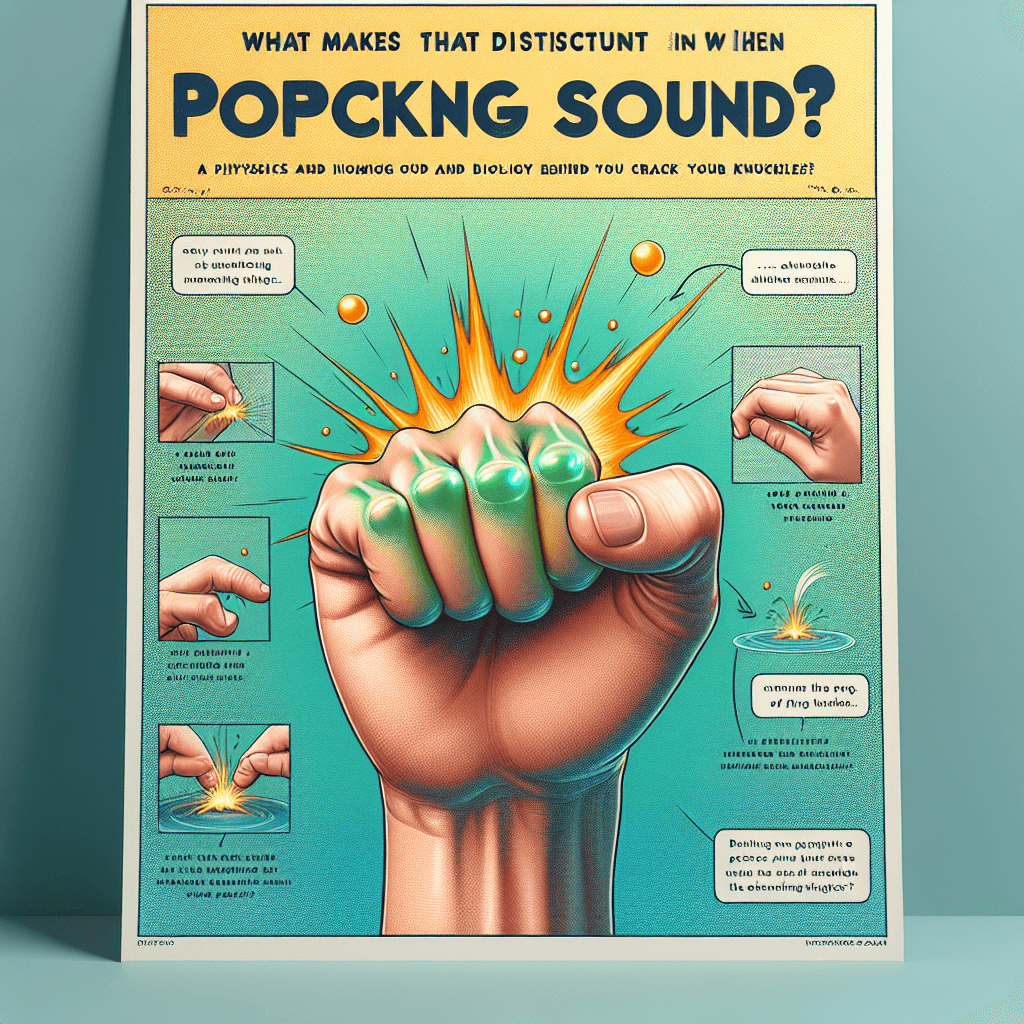Pop, Crackle, Snap: The Science Behind Cracking Your Knuckles
Ever wondered what causes that distinct popping sound when you crack your knuckles? Uncover the long-debated mystery and find out what's really happening inside your joints.


Too Long; Didn't Read
The popping sound from cracking knuckles isn't from bones grinding or ligaments snapping. This post explores the actual scientific reason for the sound.
Pop, Crackle, Snap: Unraveling the Mystery of What Makes That Distinct Popping Sound When You Crack Your Knuckles
Love it or hate it, the sound of cracking knuckles is instantly recognizable. For some, it's a satisfying habit; for others, it's nails on a chalkboard. But have you ever stopped to wonder what's actually happening inside your joints to create that distinct pop? Is it bones grinding? Ligaments snapping? For years, the exact mechanism was debated, often accompanied by warnings about long-term damage like arthritis. This post dives into the science behind the sound, exploring the leading explanation for what makes that distinct popping sound when you crack your knuckles and separating fact from fiction.
Anatomy of the "Pop": Inside Your Synovial Joints
To understand the pop, we first need a quick look at the joints typically involved – the knuckles, but also potentially knees, ankles, back, and neck. Many of these are synovial joints. Here’s what makes them special:
- Joint Capsule: A fibrous structure that encloses the joint.
- Synovial Fluid: A thick, lubricating fluid filling the joint capsule. Think of it like oil for your joints, reducing friction and nourishing cartilage.
- Cartilage: Smooth tissue covering the ends of the bones within the joint, allowing them to glide easily.
This structure creates a sealed container filled with fluid.
The Leading Theory: Bubble Trouble (Cavitation)
The most widely accepted explanation for the knuckle-cracking sound involves a phenomenon called cavitation. Here’s how it works, step-by-step:
- Stretching the Joint: When you bend or pull your finger to crack the knuckle, you rapidly increase the space between the bones within the joint capsule.
- Pressure Drop: This sudden increase in volume causes a sharp decrease in pressure within the synovial fluid.
- Gas Bubble Formation: Synovial fluid contains dissolved gases, primarily nitrogen. Just like opening a soda bottle releases dissolved carbon dioxide due to a pressure drop, the decreased pressure in the joint allows these dissolved gases to rapidly come out of solution, forming tiny bubbles.
- Bubble Collapse = The Pop: It's the rapid formation and subsequent collapse (or bursting) of these gas bubbles that is believed to create the characteristic popping sound. Studies using real-time MRI imaging have actually visualized this bubble formation coinciding with the audible pop.
- The Refractory Period: Why can't you immediately crack the same knuckle again? It takes time (often around 20 minutes) for the gases to re-dissolve back into the synovial fluid, allowing the process to potentially happen again.
Other Ideas and Debunked Myths
While cavitation is the front-runner, other theories have been proposed over the years, though they generally lack the same level of evidence:
- Snapping Ligaments: Some suggested the sound was ligaments quickly snapping taut over bone. While ligaments can sometimes make snapping sounds (like in a "snapping hip"), it's not considered the primary cause of the typical knuckle pop.
- Breaking Adhesions: Another idea was that minor adhesions within the joint were being broken.
- Bone Rubbing: This is generally discounted as the cause of the distinct pop, though grinding sounds (crepitus) can occur in joints, often related to cartilage wear, which is different.
Does Knuckle Cracking Cause Arthritis?
This is perhaps the most persistent myth associated with the habit. Generations have been warned that cracking knuckles will lead to painful arthritis later in life. However, scientific evidence largely debunks this claim.
- Long-Term Studies: Several studies have investigated the link. One notable example is Dr. Donald Unger, who famously cracked the knuckles of only one hand for over 50 years and reported no difference in arthritis between his hands. While an anecdote, it spurred further research.
- Larger Epidemiological Research: Larger studies comparing knuckle crackers and non-crackers have consistently found no significant association between habitual knuckle cracking and osteoarthritis in the hand joints. A study published in the Journal of the American Board of Family Medicine, for instance, examined elderly individuals and found no correlation.
- Minor Potential Issues?: While the arthritis link is largely unfounded, some research has suggested potential minor associations with habitual, forceful cracking, such as slightly reduced grip strength or occasional reports of ligament strain or dislocations in extreme cases. However, for the average cracker, the risk of significant harm appears minimal.
Conclusion: A Harmless Release of Gas
So, what makes that distinct popping sound when you crack your knuckles? The most compelling scientific evidence points to the formation and collapse of gas bubbles within the synovial fluid – a process called cavitation – triggered by the rapid stretching of the joint capsule. It's a fascinating display of physics occurring within our own bodies.
Despite common fears, this habit isn't scientifically linked to causing arthritis. While excessive or overly forceful cracking might theoretically cause minor issues for some, for most people, it's a harmless quirk. The next time you hear that pop, you'll know it's likely just a tiny bubble doing its thing, not your bones grinding into dust.


